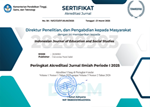Abas, M. C., & Jamila, A. (2025). Winning the Hearts of Generation Z: Personal and Digital Approaches in Educational Public Relations Management. Al-fahim: Jurnal Manajemen Pendidikan Islam, 7(1), 184-194. https://doi.org/10.54396/alfahim.v7i1.1918
Agarwal, V., & Puppala, V. N. (2024). Navigating the social media maze: assessing the evolving relevance of public relations in a digital landscape. Public Administration and Law Review, 2(18)), 34-41. https://doi.org/10.36690/2674-5216-2024-2-34-41
Bilan, Y., Oliinyk, O., Mishchuk, H., & Skare, M. (2023). Impact of information and communications technology on the development and use of knowledge. Technological Forecasting and Social Change, 191, 122519. https://doi.org/10.1016/j.techfore.2023.122519
Farid Ardyansyah, S. E., MM, C., Ridwanto Efendy, C., & Ni Wayan Merry Nirmala Yani, S. (2025). Human Capital Analytics: Mengukur Kinerja dan Produktivitas SDM. Takaza Innovatix Labs.
Fatmasari, R., Windiyani, T., & Putri, D. F. (2025, July). Artificial Intelligence as a Tool to Improve the Quality of Job-Ready Graduate Skills in Higher Education. In 2025 IEEE International Conference on Industry 4.0, Artificial Intelligence, and Communications Technology (IAICT) (pp. 129-136). IEEE. https://doi.org/10.1109/IAICT65714.2025.11101572
Fawaid, A., Hamzah, M., Munawwaroh, I., & Putri, D. F. (2025, March). AI-based career management to improve the quality of decision making in higher education. In 2025 IEEE Integrated STEM Education Conference (ISEC) (pp. 1-8). IEEE. https://doi.org/10.1109/ISEC64801.2025.11147274
George-Alexandru, I., & Cristian, S. (2023). Digital communication in public institutions. Challenges and opportunities.
Grunig, J. E., & Kim, J. N. (2021). 15 The four models of public relations and their research legacy. Public relations, 27, 277-312. https://doi.org/10.1515/9783110554250-015
Hidayat, E. W. (2024). Transformasi Digital Partisipasi Publik Dalam Proses Pembuatan Kebijakan. Jurnal Studi Interdisipliner Perspektif, 23(2), 221-232.
Hidayat, M. N. F., Aisyah, E. N., Zaini, A. W., Sanjani, M. A. F., & Hasanah, R. (2024, October). Bridging the Digital Divide: The Role of Public Relations in Enhancing Digital Inclusivity. In 2024 10th International Conference on Education and Technology (ICET) (pp. 59-66). IEEE. https://doi.org/10.1109/ICET64717.2024.10778472
Hyland-Wood, B., Gardner, J., Leask, J., & Ecker, U. K. (2021). Toward effective government communication strategies in the era of COVID-19. Humanities and Social Sciences Communications, 8(1). https://doi.org/10.1057/s41599-020-00701-w
Lovari, A., & Bowen, S. A. (2020). Social media in disaster communication: A case study of strategies, barriers, and ethical implications. Journal of Public Affairs, 20(1), e1967. https://doi.org/10.1002/pa.1967
Mansoor, M. (2021). Citizens' trust in government as a function of good governance and government agency's provision of quality information on social media during COVID-19. Government information quarterly, 38(4), 101597. https://doi.org/10.1016/j.giq.2021.101597
Mohamed, K., & Bayraktar, Ü. A. (2022). Analyzing the role of sentiment analysis in public relations: Brand monitoring and crisis management. International Journal of Humanities and Social Science, 9(3), 116-126. https://doi.org/10.14445/23942703/IJHSS-V9I3P116
Moses Alabi, A. F. (2024). The Strategic Management of Corporate Reputation in a Social Media-Driven World.
Nugraha, A. R., Sjoraida, D. F., & Novianti, E. (2022). Analisis strategi humas pemerintahan era milenial dalam menghadapi tata kelola informasi publik. PRofesi Humas, 6(2), 286-310. https://doi.org/10.24198/prh.v6i2.37095
Onyango, G., & Ondiek, J. O. (2021). Digitalization and integration of sustainable development goals (SGDs) in public organizations in Kenya. Public Organization Review, 21(3), 511-526. https://doi.org/10.1007/s11115-020-00504-2
Ozgen, E., & Saydam, S. (2022). Challenges and opportunities in the new era of communication: Digitalization and public relations. Academic Social Resources Journal, 7(42), 1121-1132. https://doi.org/10.29228/ASRJOURNAL.64766
Pinto, R., & Bhadra, A. (2024). Smarter public relations with artificial intelligence: Leveraging technology for effective communication strategies and reputation management-A qualitative analysis. REDVET-Revista electrónica de Veterinaria, 25(1), 2024. https://doi.org/10.69980/redvet.v25i1.1028
Purba, A. M., Rustiyana, H., Irawan, E. P., Juansa, A., Astari, F., & Aprinta, G. (2025). Manajemen Public Relations: Inovasi, Teknologi, dan Humanisasi Komunikasi. Star Digital Publishing,.
Puspita, D. (2025). Strategi Public Relations Kitabisa. com Dalam Menjaga Reputasi Sebagai Donation Based Crowdfunding Platform. Communicology: Jurnal Ilmu Komunikasi, 13(1), 157-185. https://doi.org/10.21009/COMM.034.010
Kent, M. L., & Li, C. (2020). Toward a normative social media theory for public relations. Public Relations Review, 46(1), 101857. https://doi.org/10.1016/j.pubrev.2019.101857
Shania, S., Ismail, F., & Karoma, K. (2024). Optimalisasi Media Digital dalam Pengelolaan Public Relations. Jurnal Inovatif Manajemen Pendidikan Islam, 3(2), 129-140. https://doi.org/10.38073/jimpi.v3i2.1616
Sugiyono. (2020). Metode Penelitian Pendidikan: Pendekatan Kuantitatif, Kualitatif, R & D. Alfabeta.
Vural, Z., Değirmen, G. Ü. L., & Ünüvar, S. (2022). Social media as a dialogical communication tool: Izmir metropolitan municipality example. Online Journal of Communication and Media Technologies, 12(2). https://doi.org/10.30935/ojcmt/11557
Westermann, A., & Forthmann, J. (2021). Social listening: a potential game changer in reputation management How big data analysis can contribute to understanding stakeholders' views on organisations. Corporate Communications: An International Journal, 26(1), 2-22. https://doi.org/10.1108/CCIJ-01-2020-0028
 (Universitas Islam Negeri Raden Intan Lampung)
(Universitas Islam Negeri Raden Intan Lampung) 



